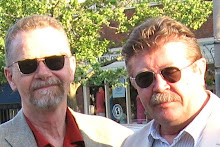Friday, October 26, 2012
THEATRE REVIEW: POLITICAL MOTHER
JOHN COULBOURN, Special to TorSun
26 OCT 2012
R: 4/5
Pictured: The Hofesh Shechter Company
Israeli-born and British-based choreographer and composer Hofesh Shechter may not be the first to cotton on to the notion that there is a certain circular (and often horrifyingly familiar) pattern to be found in the political upheavals that have rocked our world for millennia — but one can say with some degree of certainty that no one has drawn our attention to it with a louder fanfare.
As part of an extensive international tour, Shechter has brought his British-based dance company to Toronto for a very limited engagement, performing as part of the current Canadian Stage season. On offer, his highly acclaimed theatrical dance thesis, titled POLITICAL MOTHER, which opened Wednesday at the Bluma Appel Theatre.
On examination, POLITICAL MOTHER proves to be an often aggressive, sometimes reflective, work that boldly (though sometimes far from seamlessly) fuses dance and theatre, rock music and classical, in a work that while thought-provoking, proves to be jarring and too often repetitive. Built around the cycles of political violence that form so much a part of out political history, evoking everything from Japan's militaristic samurai to the fascistic pageantry that led inexorably to World War II, it is for all its faults, an often-engaging piece of work. Built around a dozen committed dancers and seven live musicians, backed by the recorded contributions of seven more, PM strives to blend an unorthodox dance vocabulary with what is often a veritable wall of sound, all intended to drive home Shechter's political
premise: a premise that seems to suggest that in the face of inevitable oppression, we are repeatedly redeemed by hope, creativity and the conviction that things can be healed, that wrongs can be righted.
Its 70 minute duration is marked by moments of touching intimacy, played out against moments of sheer horror — a samurai committing ritual suicide and a dictator haranguing a rapt audience played out in contrast to repeated images of people coming together and slowly finding a common language of movement that enables them to band together before the inevitably split into factions again. It is an often visually stunning work, using highly dramatic lighting to underscore the passion of the dancers, each of whom dons the role of oppressor and the oppressed with equal ease and conviction.
And while the sheer volume involved in the collision of metal guitar stylings and militaristic percussion often threatens to overwhelm the proceedings, it nonetheless renders the more thoughtful, classical moments woven into the fabric of the dance all the sweeter in comparison.
But finally, while one has no choice but to admire the sheer audacity of Shechter's creativity and vision, one is forced to conclude that the reach of his dance thesis has exceeded his inspiration and in the end, it all seems just a trifle repetitive. Indeed, at Wednesday's opening night performance, it seemed that too many of the audience members, enthralled though they were by Shechter's inventiveness, still managed to reach a conclusion about 20 minutes before he did.
Subscribe to:
Post Comments (Atom)




No comments:
Post a Comment